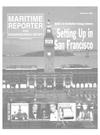
Page 14: of Maritime Reporter Magazine (September 2003)
Read this page in Pdf, Flash or Html5 edition of September 2003 Maritime Reporter Magazine
Government Update phere. Other vectors for non-indigenous species to reach new environments range from intentional introduction (as when the Brown trout was brought to
North America from Germany in the
I880's) to the unintentional (as when
Caulerpa taxifolia. an exotic seaweed, was introduced into San Diego Bay by the emptying of aquariums). Recently. the state of Virginia proposed to import
Asian oysters to plant in the Chesapeake
Bay in an attempt to counteract the mas- sive decline in domestic oysters.
In an effort to slow the spread of aquatic non-indigenous species, ballast water management programs have been introduced. One of the first was man- dated for ships entering the Great Lakes from outside North America. These ships are required to demonstrate that they have exchanged their ballast water on the high seas while en route. High seas ballast water exchange remains the most widely accepted and widely uti- lized of the control techniques. This is true despite its downsides. Disposal of ballast water on the high seas may the-art computer keeping everything under control. Our steering and propulsion systems are made from long-lasting bronze and stainless steel.
Add our microprocessor, and you've got a flexible, integrated system that will take
Manufacturing has been producing high quality marine controls and steering for over 35 years. We back every one of our products with a 5 year warranty, along with worldwide sales and support.
Contact us todav!
KOBEIT Quality Control 8238 129th Street. Surrey. British Columbia. Canada Y3\V 0A6
E-mail: .sales®kobelt.com Website: www.kohelt.com
Sales: S90.7313 Fax: M1-t.S90.8313
Circle 237 on Reader Service Card 14 expose the ship to stability risks, partic- ularly in heavy weather. Even the best current ballast water pumping systems do not fully empty the ballast tanks, leaving some water and sediment (along with the potential for non-indigenous critters) in the tanks when they are refilled. Some ships transit exclusively in coastal or shallow-water areas where ballast water exchange may provide minimal value. Australia has introduced a ballast water management program that includes a risk analysis to determine the likelihood that a ship's ballast water might contain harmful non-indigenous species.
Ballast Water and Other Guidelines
To reduce the probability that ballast water would contain significant num- bers of non-indigenous species, the
International Maritime Organization (IMO) established a set of voluntary guidelines. These include cautions against uptake of ballast water in very shallow water or in darkness when bot- tom-dwelling organisms may rise up the water column. These guidelines have been adopted by the U.S. Coast Guard (and have been made mandatory by the
State of California).
The U.S. initially adopted a voluntary approach to ballast water management (except in Great Lakes and in the
Hudson River north of the George
Washington Bridge). The original pro- gram included a requirement that ships arriving from overseas report what bal- last water management techniques were utilized on the voyage, but the tech- niques were only recommended and there was no penalty for not utilizing any and there was no penalty for failure to make the report. After three years, the results were not good. Only about 30 percent of arriving ships submitted the reports and only about 50 percent of the reporting ships stated that they had exchanged their ballast water or utilized other techniques. Based on these results, ihe U.S. Coast Guard is engaged in a rulemaking project that will estab- lish civil penalties for failure to under- take ballast water management tech- niques and for failure to provide the required reports.
The IMO is engaged in a similar effort to improve ballast water management programs. A draft International
Convention for the Control and
Management of Ships' Ballast Water and
Sediments has been prepared. An
International Conference has been scheduled for February 2004 to consider and approve the Convention. Wide adoption of the Convention is expected to follow rapidly.
Maritime Reporter & Engineering News

 13
13

 15
15
